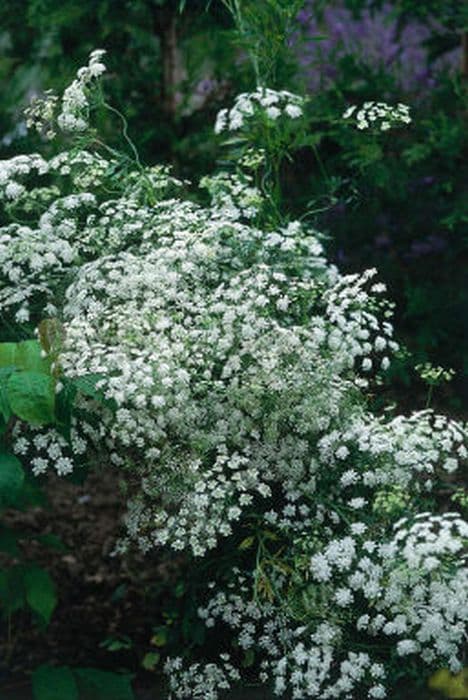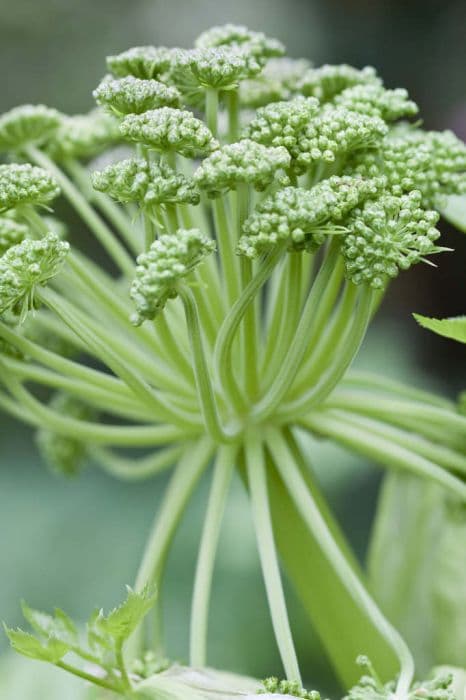Bishop's weed Aegopodium podagraria 'Variegatum' (v)

ABOUT
Aegopodium podagraria 'Variegatum,' commonly known as variegated ground elder, is a perennial plant known for its distinctive foliage. The leaves of variegated ground elder are compound, with each leaf consisting of smaller, roughly triangular leaflets arranged in groups. What sets this variety apart is the striking variegation pattern on the leaves; they have a unique blend of green and creamy-white hues. The creamy-white often edges the leaflets, creating a bright contrast with the darker green at the center. During the blooming season, the plant produces small, umbrella-like clusters of flowers that can add a delicate touch of white to the foliage below. These flowers typically grow in loose clusters and can add to the ornamental appeal of the plant. Its lush and variegated foliage makes it popular for use as ground cover in gardens.
About this plant
 Names
NamesFamily
Apiaceae.
Synonyms
Snow-On-The-Mountain, Bishop's Weed, Goutweed, Variegated Ground Elder.
Common names
Aegopodium podagraria 'Variegatum'.
 Toxicity
ToxicityTo humans
The plant commonly known as Ground elder is not considered highly toxic to humans. However, it may contain compounds that can cause mild stomach upset if ingested in large quantities. It is not generally known for causing severe poisoning or life-threatening symptoms when consumed.
To pets
For pets, the Ground elder is also not recognized as being highly toxic. As with humans, ingestion of this plant by pets might result in mild gastrointestinal upset, like vomiting or diarrhea, but it is not expected to cause severe poisoning or long-term health issues. It's always a good practice to prevent pets from eating large amounts of any non-food plants, as they may cause digestive issues or allergic reactions.
 Characteristics
CharacteristicsLife cycle
Perennials
Foliage type
Deciduous
Color of leaves
Variegated
Flower color
White
Height
1-2 feet (30-60 cm)
Spread
1-3 feet (30-90 cm)
Plant type
Herb
Hardiness zones
3-9
Native area
Europe Asia
Benefits
 General Benefits
General Benefits- Low Maintenance: Aegopodium podagraria 'Variegatum', commonly known as Variegated Bishop's Weed, requires minimal care once established, making it suitable for gardeners of all skill levels.
- Rapid Growth: This plant spreads quickly and can cover large areas, filling in garden spaces rapidly and providing an instant effect.
- Attractive Foliage: The variegated leaves of the Bishop's Weed add visual interest and contrast to the garden with their green and white patterns.
- Shade Tolerance: It thrives in shaded areas where other plants might struggle, making it an ideal groundcover for woodland gardens or shady borders.
- Erosion Control: With its dense mat-forming habit, it helps in preventing soil erosion on slopes or in areas prone to erosion.
- Drought Tolerant: Once established, it is relatively drought-tolerant, reducing the need for frequent watering.
- Soil Adaption: It can grow in a variety of soil conditions, from dry to damp, making it versatile for different garden situations.
- Weed Suppression: The thick growth habit of Bishop's Weed can help to suppress weeds, reducing garden maintenance tasks.
- Cold Hardy: It is resilient in colder climates and can survive through frosts and snow, maintaining ground cover year-round.
- Easy to Propagate: Variegated Bishop's Weed is easily propagated by division, allowing gardeners to expand their plantings or share with others.
 Medical Properties
Medical Properties- Anti-inflammatory: Aegopodium podagraria, commonly known as ground elder, has been used in traditional medicine for its potential anti-inflammatory properties, which might aid in reducing swelling and pain associated with conditions like gout and arthritis.
- Diuretic: It may offer diuretic effects that can promote the excretion of urine, potentially supporting the body's ability to eliminate waste and reduce fluid retention.
- Digestive aid: Ground elder has been used as a digestive aid in folk medicine, potentially helping with indigestion and other gastrointestinal issues.
 Air-purifying Qualities
Air-purifying QualitiesThis plant is not specifically known for air purifying qualities.
 Other Uses
Other Uses- Garden Border: Goutweed's dense foliage and rapid growth makes it effective for forming tidy, low-maintenance garden borders.
- Ground Cover: In areas where lawn mowing is challenging, goutweed can be used as a ground cover to prevent soil erosion.
- Companion Planting: Goutweed can be planted alongside other plants to fill in spaces quickly, preventing weeds from establishing.
- Shade Gardens: Its variegated leaves brighten up shady spots in gardens where other plants might struggle due to a lack of light.
- Culinary Arts: Young leaves of goutweed can be used in salad mixes or as a cooked green, although this is less common due to its potential invasiveness.
- Leaf Mold: Decaying leaves of goutweed can contribute to a nutrient-rich leaf mold for garden use.
- Crafts: Dried goutweed can be used in floral arrangements or for making eco-friendly crafts.
- Livestock Feed: In the past, goutweed was used as fodder for animals, particularly in times of shortage.
- Education: Goutweed can be used in educational settings to teach about invasive species and ecosystem management.
- Photography: The plant's variegated leaves can serve as an attractive subject or backdrop for nature photography.
Interesting Facts
 Feng Shui
Feng ShuiThe Bishop's Weed is not used in Feng Shui practice.
 Zodiac Sign Compitability
Zodiac Sign CompitabilityThe Bishop's Weed is not used in astrology practice.
 Plant Symbolism
Plant Symbolism- Invasiveness: Aegopodium podagraria 'Variegatum', commonly known as Goutweed or Bishop's Weed, has a reputation for its aggressive growth, commonly symbolizing persistence and the ability to take over an area or situation, much like certain characteristics can dominate a person's life.
- Medicinal Use: Historically, Goutweed was used to treat gout and arthritis, which can symbolize healing and relief. This association comes from its traditional use as a herbal remedy for these ailments.
- Adaptability: Its variegated variety adapts well to various environments and can flourish in shade, symbolizing adaptability and the ability to thrive even in less than ideal conditions.
 Water
WaterGoutweed should be watered regularly to maintain a consistently moist soil environment. During the growing season, water the plant thoroughly, ensuring that water penetrates deeply into the soil, which may require about 1 to 2 inches of water per week depending on the weather and soil conditions. It tolerates some dryness once established, but in the absence of rainfall, make sure to water at least once a week. Overhead watering or using a drip system can both be effective, but avoid overwatering as this can lead to root rot. During winter or in periods of rain, reduce the frequency to match the plant's reduced water requirements.
 Light
LightGoutweed thrives in part shade to full shade conditions; therefore, the best spot for the plant is an area that receives filtered sunlight or no direct sun. It is adaptable and can handle some morning sun, but in hot climates, it prefers more shade to prevent the leaves from scorching. Avoid placing it in full sun locations, where the leaves may wilt and lose their variegation.
 Temperature
TemperatureGoutweed prefers temperature conditions that mimic its native woodland habitat. It can survive in temperatures that range roughly from 40°F to around 80°F. The ideal temperature for goutweed is between 60°F and 70°F. Protection from extreme cold and heat can ensure the plant remains healthy and doesn't succumb to frost or heat stress.
 Pruning
PruningPruning goutweed helps control its growth and remove any damaged or dead foliage. Prune in early spring or late fall by cutting back the plant's invasive runners and trimming off any unwanted areas to maintain desired size and shape. Pruning can be necessary several times throughout the growing season if the plant begins to encroach on other garden spaces. Always use sharp, clean pruning shears for clean cuts.
 Cleaning
CleaningAs needed
 Soil
SoilGround elder requires fertile, moist soil with good drainage for optimal growth. A potting mix consisting of equal parts garden soil, peat, and perlite will ensure the right texture and fertility. It prefers a soil pH of 6.0 to 7.0.
 Repotting
RepottingGround elder can be quite invasive, so repotting is seldom necessary unless grown in containment. In containers, repot every 2-3 years to refresh the soil.
 Humidity & Misting
Humidity & MistingGround elder is not particular about humidity and can thrive in average room humidity levels. Outdoor conditions are typically suitable without the need for special humidity adjustments.
 Suitable locations
Suitable locationsIndoor
Provide bright light, moist soil, and space for spreading.
Outdoor
Plant in semi-shade, ensure moist soil, manage invasiveness.
Hardiness zone
4-9 USDA
 Life cycle
Life cycleAegopodium podagraria 'Variegatum,' commonly known as Variegated Bishop's Weed or Goutweed, begins its lifecycle with the germination of seeds or the sprouting of rhizomes in early spring. The plant grows rapidly, forming a low-lying, herbaceous mat of variegated leaves that are creamy-white and green. Throughout late spring and early summer, it blooms with small, white flowers arranged in umbrella-like clusters called umbels, which can lead to seed production if pollinators are present. After flowering, the plant may set seed, which disperses in the environment, while the underground rhizomes also spread, contributing to its invasive growth habit. As autumn approaches, the aboveground foliage of Variegated Bishop's Weed dies back with the onset of colder temperatures, but the perennial rhizomes remain alive underground. The plant reemerges from these rhizomes each spring, continuing its lifecycle.
 Propogation
PropogationPropogation time
Spring-early summer
Bishop's weed, also known as Aegopodium podagraria 'Variegatum', is typically propagated by dividing the root system. This plant is known for its aggressive spreading, which should be considered when planning division. The best time to propagate Bishop's weed by division is in early spring or early fall when the plant is not in active bloom. To propagate, carefully dig up an established clump of the plant, ensuring a generous amount of roots are included. Using a sharp shovel or knife, divide the clump into smaller sections, each with several shoots and a portion of the root system. Replant the divisions immediately at the same depth they were originally growing, watering them well to help establish in their new locations.









